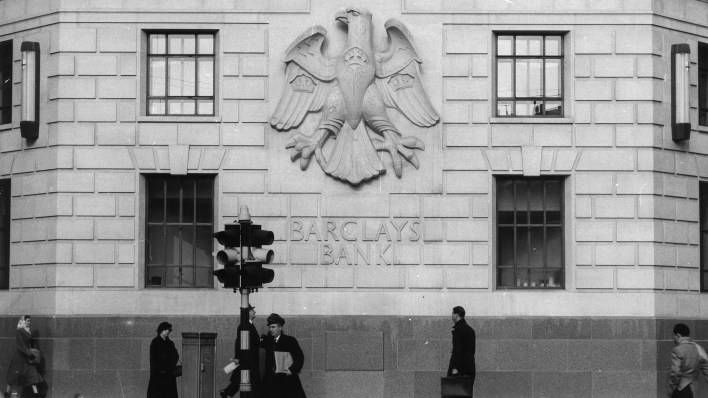
Barclays Group Archives
Barclays Group Archives are home to the records of Barclays PLC and its predecessors, dating from 1567 to the present day
Business historian Professor Leslie Hannah talks about Barclays' long history and its role in society during this time.
Barclays was first represented in Kent with the opening of a branch in Tunbridge Wells in around 1817. Unfortunately, we do not have a precise opening date but there is an entry in J Sprance's "Tunbridge Wells Guide" for 1817 which reads "Hurly, Molineux, Whitfield and Dicker, Lewes Old Bank in the Pantiles". The Bank's agent was John Nash who also ran the library and post office. The Lewes Old Bank was formed in 1789 under the partnership of Messrs. Whitfield, Comber, Molineux and King. Their partners are named in the Articles of Agreement as Francis Whitfield of Lewes, grocer; Benjamin Comber of Steyning, Gentleman; Joseph Molineux of Lewes, ironmonger, and Richard King of Lewes, tallow chandler.
Over the years there were several changes in the partnership but all came under the name of the Lewes Old Bank. In 1896, the Lewes Old Bank was one of the twenty private banks which merged to form Barclay and Company Ltd. Other branches were opened in Kent by the London and Provincial Bank Ltd including Beckenham in 1874 and Gillingham in 1889. The Provincial Banking Corporation Ltd was formed in 1864 and changed its name to the London and Provincial Bank Ltd in 1870. It amalgamated with the London and South Western Bank Ltd in December 1917 and became the London Provincial and South Western Bank Ltd. They merged with Barclays Bank Ltd in October 1918. Other branches were opened by Martins Bank Ltd including Bromley in 1888 and Dartford in 1891.
Canterbury branch after The Blitz
Martins could trace its history back to Elizabethan times and Sir Thomas Gresham, the influential London goldsmith. Barclays and Martins merged in 1969. A Local Head Office was opened at Canterbury on 11 May 1925 with responsibility for Ashford (opened 23 January 1922); Sittingbourne (opened 25 June 1923); Faversham (opened 10 June 1924); Herne Bay (opened 21 February 1923); Hythe (opened 7 July 1924); Folkestone (opened 15 February 1923); Dover (opened 10 August 1914); Sandwich (opened 1 January 1914); Ramsgate (18 April 1921); Broadstairs (January 1920); Cliftonville (1920); Margate (18 April 1921) and Whitstable (16 November 1925). Expansion of the district began in 1935 when a branch was opened at Westgate and, in 1936, another at Cheriton. In 1937, the branches at Maidstone, Strood, Rochester, Chatham, Gillingham, Sheerness, Sevenoaks and Westerham came under the control of Canterbury from London district. Tonbridge was transferred from the Lewes district and Rye, Cranbrook and Tenterden from the Eastbourne Local Head Office.
In September 1947, the LHO was transferred to Maidstone and the district renamed the Canterbury and Maidstone District. The two Tunbridge Wells branches, Mount Pleasant and Pantiles, were taken over from Brighton LHO in the same year and in 1950, Gravesend and Northfleet came in from London District. This meant that the whole of Kent outside of London was now under one LHO.
In the pre-war era the main types of business conducted in Kent were fruit farming, hop gardening (mainly around Canterbury, Maidstone and Tonbridge) general farming, sheep farming on Romney Marsh, and brewing. The Kent coal field was situated in the area bounded by Canterbury Chislet, Sandwich, Deal and Dover. The Medway Valley had a number of paper mills while the manufacture of cement was a major industry in North Kent.
The sea played an important role in the business activities of the LHO. These included the dockyards at Chatham and Sheerness, the cross channel passenger and goods traffic from Dover and Folkestone and the famous oyster beds at Whitstable. In the coastal areas, there were many hotels and boarding houses providing welcome business for Barclays. The Second World War had a disastrous effect on Kent as a whole as well as Barclays business there. After Dunkirk in 1940, the LHO was transferred to Tonbridge as a precautionary measure, leaving only Staff Administration at Canterbury. In East Kent many customers withdrew their accounts or were transferred at the instigation of the Bank to safer inland branches. The number of accounts at Dover was reduced by over fifty per cent, at Folkestone by over sixty per cent and the Thanet branches by over forty per cent. Cheriton, Cliftonville and Westgate were closed and Broadstairs became a sub-branch to Ramsgate.
As well as these disruptions to the banking business, almost all the branches suffered damage from enemy action. Canterbury branch was almost completely destroyed in the Baedeker Raid on the night of May 31 - June 1 1942. What was once a three-storey building in the main street, surrounded by houses became a single-storey building, completely alone, all the surrounding property razed to the ground. Fortunately, there were no casualties. Business was continued in the premises of Lloyds Bank until the building was inhabitable. Dover branch also suffered badly from bomb damage. It had already been hit eleven times when on a Sunday night in 1943, a shell demolished the adjoining house and wrecked the entire ground floor of the branch. Business, however, continued the following day in temporary premises.
